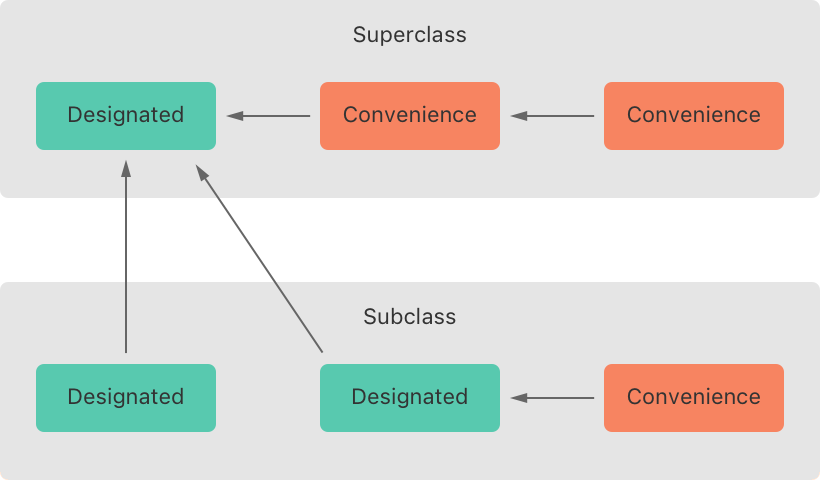Swift - 类初始化指南
Designated Initializers和Convenience Initializers
Rule 1
A designated initializer must call a designated initializer from its immediate superclass.
Rule 2
A convenience initializer must call another initializer from the same class.
Rule 3
A convenience initializer must ultimately call a designated initializer.

Safety check 1
A designated initializer must ensure that all of the properties introduced by its class are initialized before it delegates up to a superclass initializer.
As mentioned above, the memory for an object is only considered fully initialized once the initial state of all of its stored properties is known. In order for this rule to be satisfied, a designated initializer must make sure that all of its own properties are initialized before it hands off up the chain.
Safety check 2
A designated initializer must delegate up to a superclass initializer before assigning a value to an inherited property. If it doesn’t, the new value the designated initializer assigns will be overwritten by the superclass as part of its own initialization.
Safety check 3
A convenience initializer must delegate to another initializer before assigning a value to any property (including properties defined by the same class). If it doesn’t, the new value the convenience initializer assigns will be overwritten by its own class’s designated initializer.
Safety check 4
An initializer can’t call any instance methods, read the values of any instance properties, or refer to self as a value until after the first phase of initialization is complete.
The class instance isn’t fully valid until the first phase ends. Properties can only be accessed, and methods can only be called, once the class instance is known to be valid at the end of the first phase.
Phase 1
A designated or convenience initializer is called on a class.
Memory for a new instance of that class is allocated. The memory isn’t yet initialized.
A designated initializer for that class confirms that all stored properties introduced by that class have a value. The memory for these stored properties is now initialized.
The designated initializer hands off to a superclass initializer to perform the same task for its own stored properties.
This continues up the class inheritance chain until the top of the chain is reached.
Once the top of the chain is reached, and the final class in the chain has ensured that all of its stored properties have a value, the instance’s memory is considered to be fully initialized, and phase 1 is complete.
Phase 2
Working back down from the top of the chain, each designated initializer in the chain has the option to customize the instance further. Initializers are now able to access self and can modify its properties, call its instance methods, and so on.
Finally, any convenience initializers in the chain have the option to customize the instance and to work with self.
